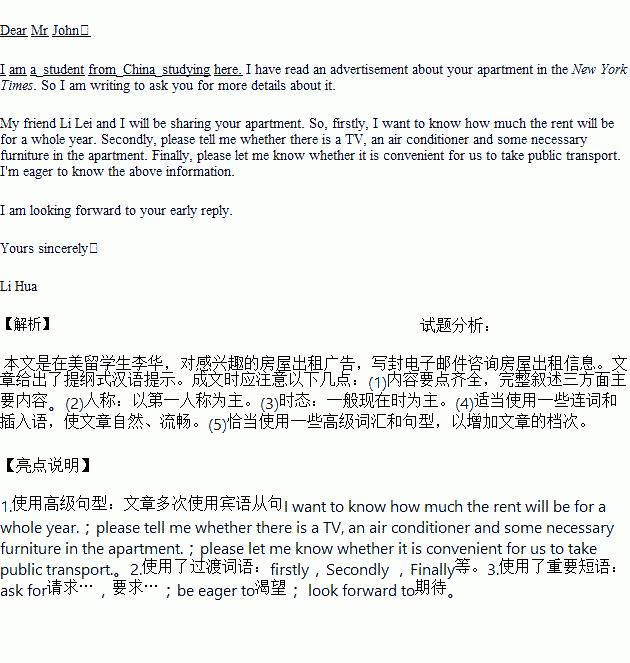题目内容
假如你是李华,在美国留学,你在《纽约时报》(New York Times)上看到了一则约翰先生的房屋出租广告,你对此感兴趣,特意发电子邮件咨询,要点如下:
1.租一年的价格;
2.房内是否有家具、电视、空调等;
3.交通是否方便。
注意:1.词数100左右;
2.可以适当增加细节,以使行文连贯;
3.开头语已为你写好,不计入总词数。
Dear Mr John,
I am a student from China studying here.________________________________________________________
________________________________________________________________________________________
________________________________________________________________________________________
________________________________________________________________________________________
________________________________________________________________________________________
________________________________________________________________________________________
________________________________________________________________________________________
________________________________________________________________________________________
________________________________________________________________________


 me, the method of tugui, earth sundial(日暑), was used to measure the shadow of the sun for determining the solar terms.
me, the method of tugui, earth sundial(日暑), was used to measure the shadow of the sun for determining the solar terms. e intangible cultural heritage of humanity
e intangible cultural heritage of humanity ter which an employee brings the meal directly to the table.
ter which an employee brings the meal directly to the table. n New
n New  York's Tribeca neighbourhood on Thursday, said the company has long expected customers to adapt to its business model of ordering at the counter and then waiting to collect their own food. Now, he said, “We're adapting our business around customers.”
York's Tribeca neighbourhood on Thursday, said the company has long expected customers to adapt to its business model of ordering at the counter and then waiting to collect their own food. Now, he said, “We're adapting our business around customers.” lity and realizing that________are only stepping-stones to final success. After many attempts, many failures, many lessons and many false starts, learn valuable lessons from failure, tum dreams into________, and don't let a dream only be a dream, success will arrive at last.
lity and realizing that________are only stepping-stones to final success. After many attempts, many failures, many lessons and many false starts, learn valuable lessons from failure, tum dreams into________, and don't let a dream only be a dream, success will arrive at last. ition
ition is isn’t like any old hospital, however. Today Carpenter isn’t in bed but sitting in a chair, dressed in her own clothes, a fat Dan Brown book in front of her. “You don’t feel like you’re in hospital,” she says.
is isn’t like any old hospital, however. Today Carpenter isn’t in bed but sitting in a chair, dressed in her own clothes, a fat Dan Brown book in front of her. “You don’t feel like you’re in hospital,” she says.